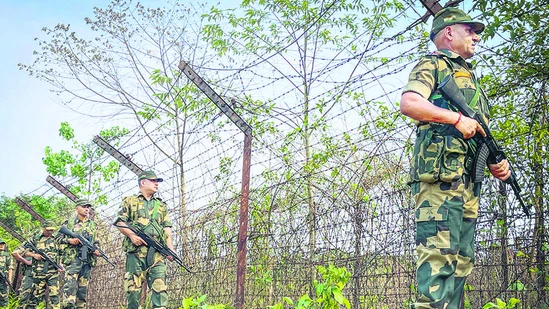At least 120 terrorists gathered every month since December last year across the Line of Control (LoC), both opposite the Jammu region and the Kashmir Valley, to infiltrate into India and carry out three type of attacks — regular terrorist shooting incidents, border action team (BAT) operations and improvised explosive device (IED) explosions — according to central intelligence agency officials.
Around 167 terrorists were present across the border waiting to cross over in December last year, 146 were present in January this year, 138 in February and 122 in March, according to officials who cited intelligence inputs.
This number averaged around 40-50 terrorists ready to infiltrate in the corresponding months last year, officials said.
The spike in numbers suggested that Pakistan army and spy agency Inter-Services Intelligence ramped up its activities for past three-four months in the run up to the April 22 Pahalgam attack that killed 26 people. Pakistan-based terror outfit Lashkar-e-Taiba’s proxy, The Resistance Front (TRF), claimed responsibility for the attack that coincided with US vice president JD Vance’s visit to India. New Delhi has since identified three Pakistani terrorists and used signal intelligence to underline Islamabad’s role in the attack.
A ceasefire was announced along the international border (IB) and LoC in February 2021.
“We had information since late 2023 and early 2024 that Pakistan had activated several terrorists launch pads across the LoC and International Border (IB),” said an officer, requesting anonymity.
“Some 40-50 terrorists attempted to enter every month between January and March last year. But from December 2024 onwards, Pakistan army and ISI activated its entire terror machinery. From Gurez, Uri and Keran sectors in Valley to Bhimber Gali, Poonch, Krishna Ghati and Samba in Jammu, over 167 terrorists were present in launch pads across the border, armed and ready to enter. In January, February and March too, over 120 terrorists each were present across the border, and they had orders to carry out regular shooting incidents, BAT attacks and IED blasts,” the officer said, citing intelligence inputs.
It is not known how many of these terrorists managed to sneak into India, but officials say 55-60 Pakistan terrorists could be hiding in various districts in J&K.
BAT teams of Pakistan usually involve 5-6 regular army officers and terrorists, who conduct guerilla overnight raids to kill soldiers on the Indian side, mostly by beheading them. After the action, these BAT teams return to Pakistan army posts, which also double as terror launch pads.
The intelligence agencies say that almost 80% of terrorists concentrated across the border in various launch pads belong to the Lashkar-e-Taiba (LeT), while others are associated with the Jaish-e-Mohammad (JeM) and Al-Badr.
Even though the Border Security Force (BSF) and the army regularly look for infiltration routes, they have been directed after the April 22 attack “to find if Pakistan has managed to dig very deep tunnels, under the trenches, to facilitate infiltration and even send soldiers in case of any armed conflict”, said a second officer, requesting anonymity.
The assessment by BSF officers, army and the intelligence agencies is that Pakistan put its ex-servicemen just across the border not only to act as first responders but also to provide their compounds for digging trans-border tunnels. Pakistan has also deliberately kept certain pockets on its side of border full of tall elephant grass to conceal the movement of terrorists, the second officer said.
One of the tunnels discovered by forces in 2020 was 500 metres long, 30 metres deep and went almost 200 metres inside Pakistan’s side, and had an oxygen pipe for infiltrators to breathe while they wait there to cross over, a third officer said.
In fact, Umar Farooq, nephew of JeM chief Maulana Masood Azhar, who was involved in 2019 Pulwama attack, used a tunnel in the Samba sector to enter India in April 2018. Similarly, four attackers in 2016 Nagrota camp attack also used a tunnel to infiltrate.
“While we have deployed anti-tunnel technology and physical checks are being carried out on entire border, we don’t know if Pakistan has managed to dig very deep tunnels with their mouth on Indian side untraceable,” said the third officer.
Since 2001, India has discovered around 22 tunnels used by Pakistan to send terrorists, but agencies do not rule out the presence of more.
